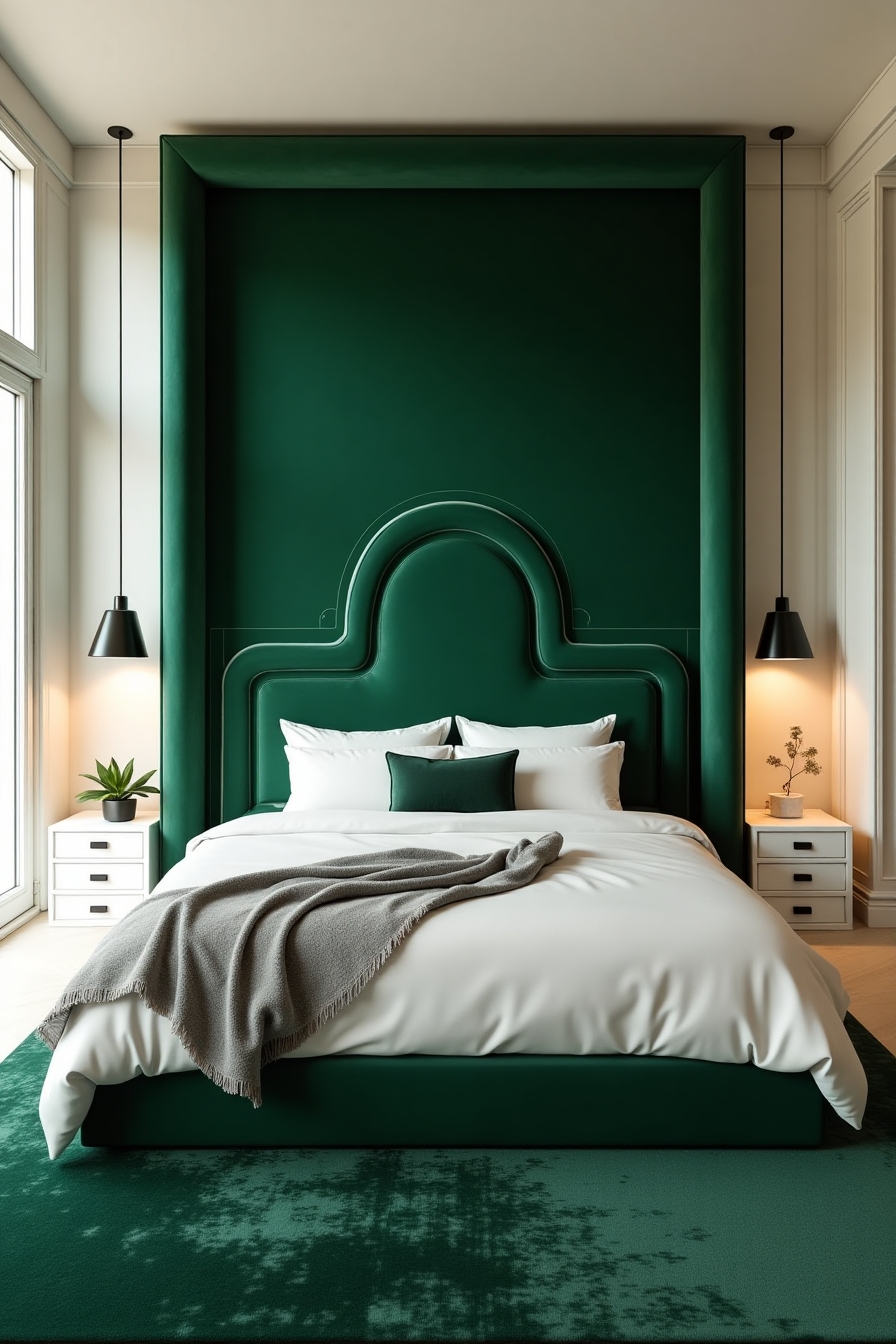There’s something magical about green and white color combination—it brings the refreshing energy of nature indoors while maintaining a clean, timeless aesthetic that never goes out of style.
I have created an interesting list of the ideas with these designs.
✨Click to Get My 101 FREE Designer Room Ideas
The Minimalist Sanctuary: Forest Green and Crisp White
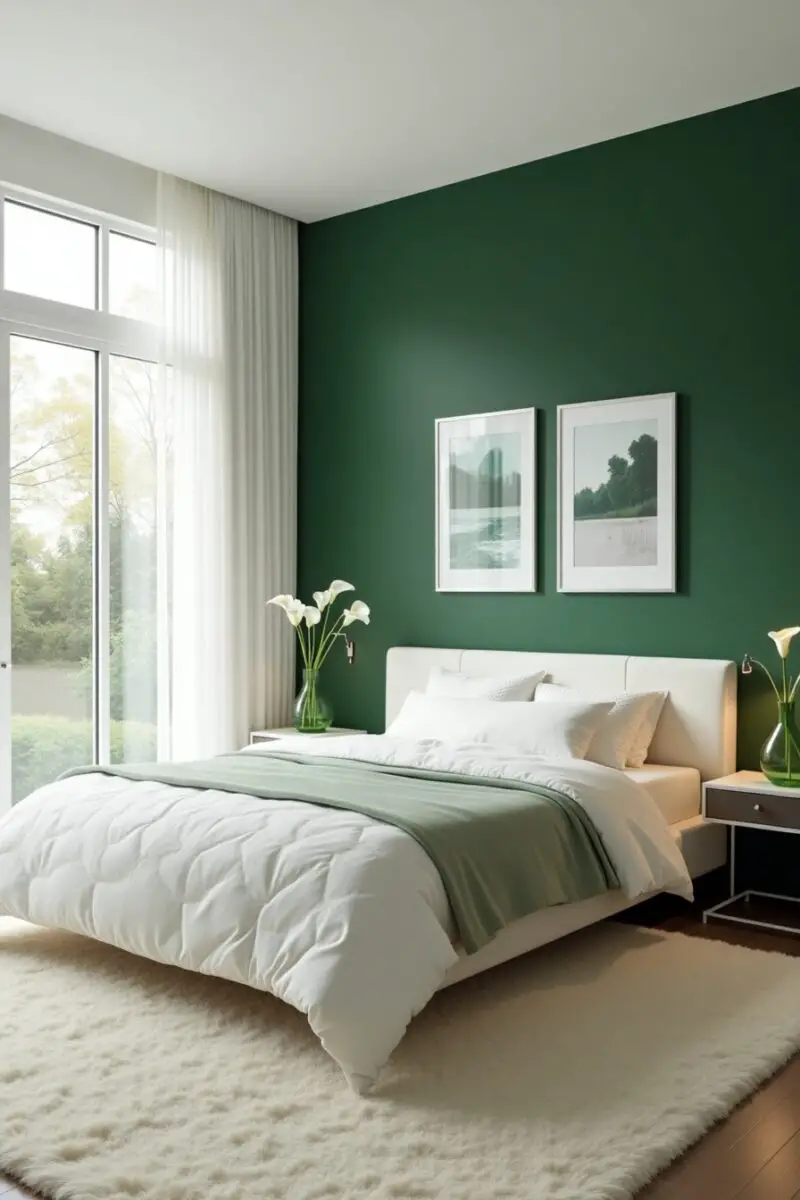
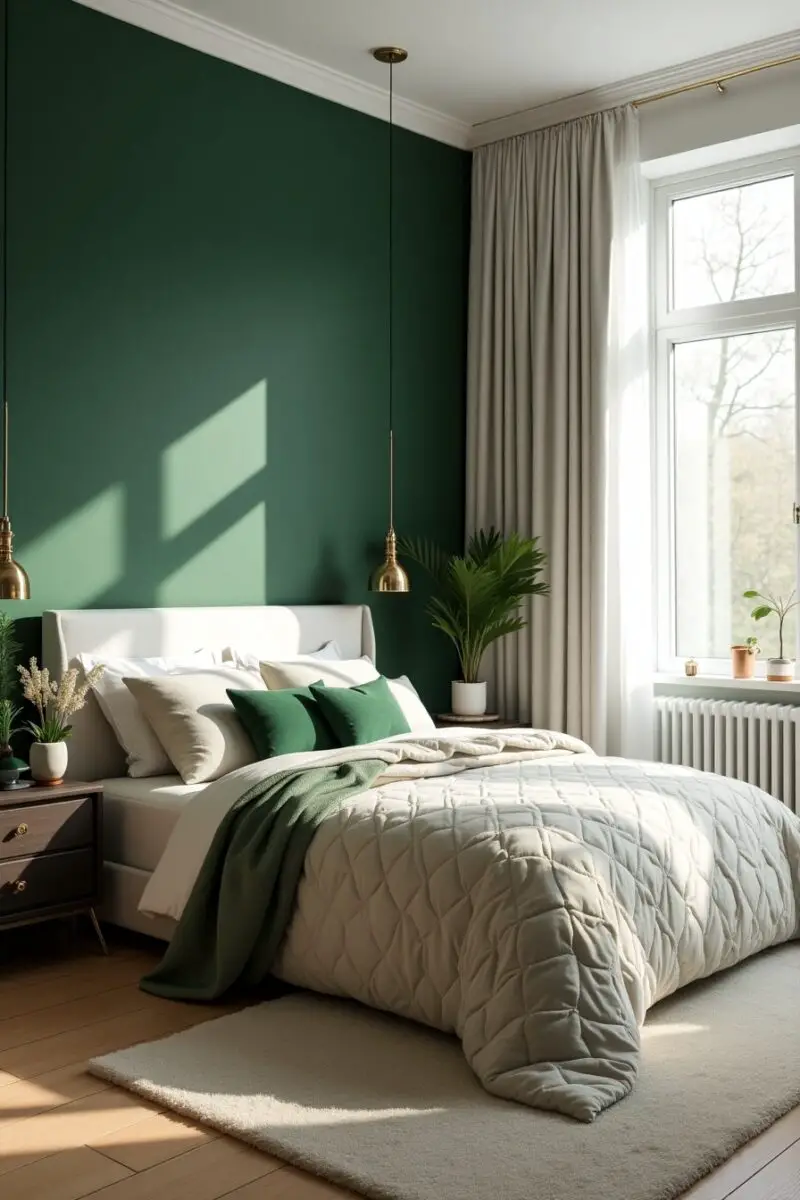
Forest green is making a major comeback in bedroom design, especially when paired with crisp, bright whites.
The key to this look is embracing negative space and letting the bold contrast between deep forest green and bright white create visual interest without clutter.
Start with a forest green accent wall behind your bed – this rich, sophisticated shade instantly adds depth and creates a stunning focal point.
Keep your bed frame and larger furniture pieces in clean white to prevent the space from feeling too dark or heavy.
Choose bedding in various textures of white – think crisp cotton sheets, a chunky knit throw, and linen pillow cases – to add dimension without disrupting the minimal color scheme.
Add one statement piece in a natural material, like a rattan pendant light or a solid wood bench at the foot of the bed, to bring warmth to the space.
For artwork, select black and white photography or simple line drawings in thin black frames to maintain the minimalist aesthetic.
Window treatments should be sheer white to maximize natural light while maintaining privacy.
Flooring works beautifully in either light wood tones or a plush white area rug if you have darker floors.
Keep decorative objects to a minimum – perhaps a single large plant like a fiddle leaf fig in the corner, a streamlined white ceramic vase, and a small stack of design books on your nightstand.
Lighting should be intentional and architectural – consider wall-mounted reading lights with adjustable arms rather than traditional table lamps.
The beauty of this color scheme lies in its versatility; forest green works equally well with warm whites for a cozier feel or cool whites for a more modern edge.
For a twist on this look, consider introducing forest green through an upholstered headboard or plush velvet curtains while keeping walls white.
Your nightstands can be floating shelves instead of traditional tables to enhance the minimalist vibe and create a sense of spaciousness.
If you’re hesitant to commit to a green wall, invest in high-quality forest green bedding against white walls for a similar impact that’s easier to change.
Storage should be concealed wherever possible – look for white wardrobes that blend into white walls to maintain the clean, uncluttered aesthetic.
The forest green and white combination creates a sanctuary-like atmosphere that feels both grounding and spacious – exactly what a bedroom should be.
This color palette works year-round but feels especially appropriate in fall and winter months when you’re craving that connection to evergreen nature.
For the ultimate minimalist touch, keep your electronics hidden and your surfaces clear except for essential items.
Modern Farmhouse: Sage Green and Ivory Elegance
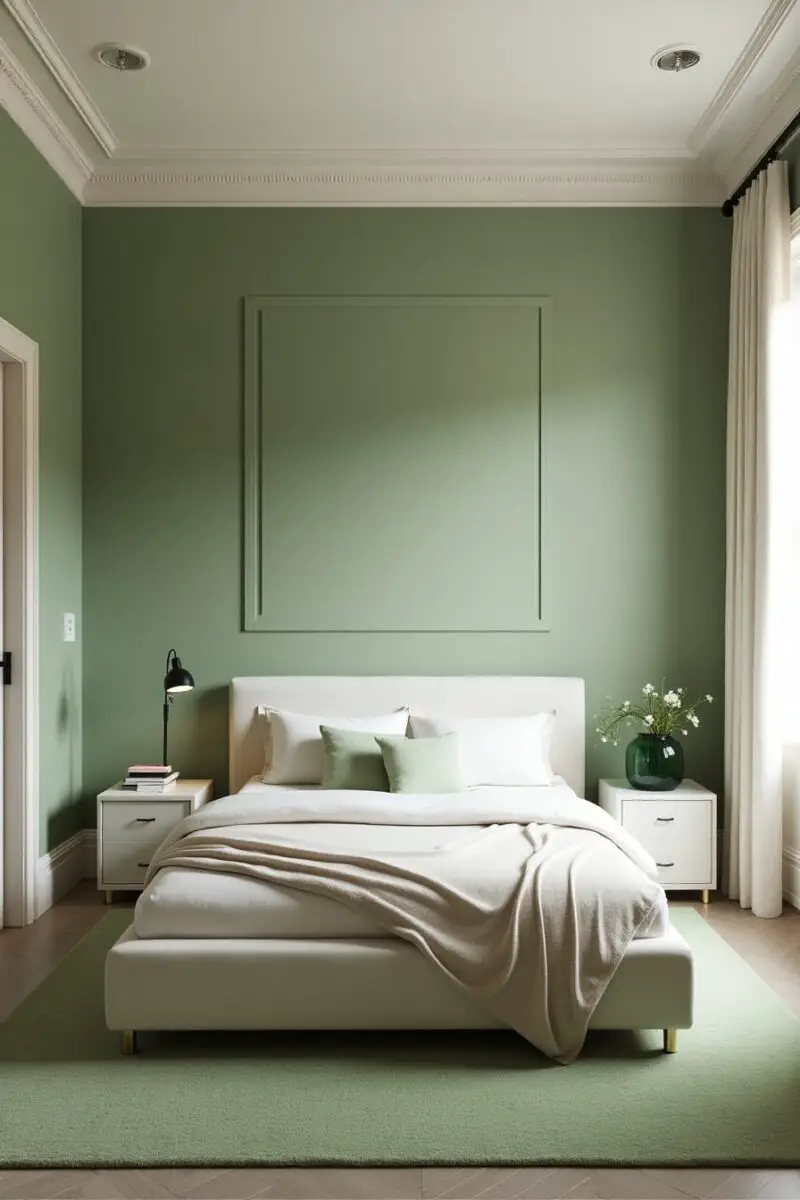
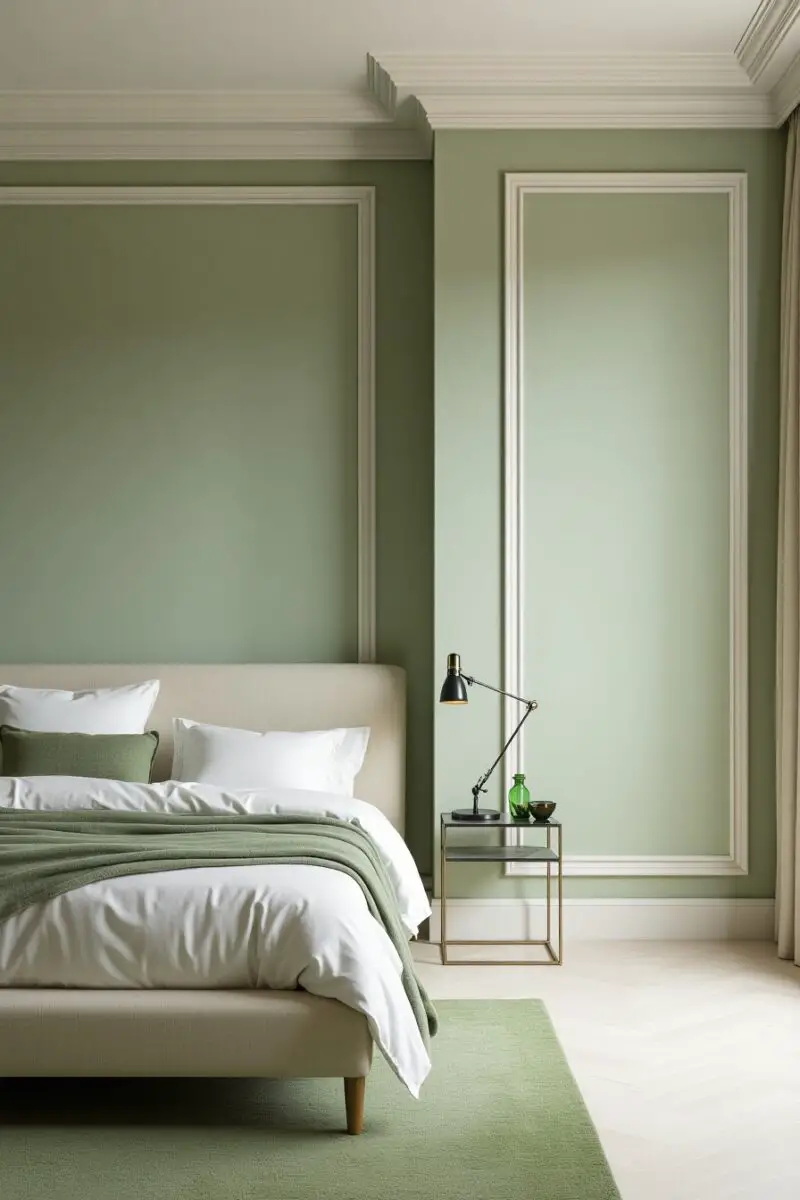
Sage green paired with soft ivory creates the perfect foundation for a modern farmhouse bedroom that feels both contemporary and timeless.
This color combination offers a subtle, sophisticated take on the green and white theme that works beautifully with the rustic elements of farmhouse style.
Start with walls in a matte sage green – this understated, grayed-down green creates a soothing backdrop for ivory textiles and wooden accents.
Choose a substantial wooden bed frame in a weathered or whitewashed finish that brings character without feeling too rustic or theme-y.
Layer your bed with ivory linens in natural fabrics like cotton, linen, and chambray – focusing on texture rather than pattern to create visual interest.
Incorporate a chunky knit throw in a slightly darker shade of sage or a soft ivory to add dimension and coziness.
For window treatments, consider simple linen panels in ivory hung from black iron rods, or wooden shutters painted in soft white for architectural interest.
Install shiplap on one wall, painted in a creamy white or ivory, to add that quintessential farmhouse texture without overwhelming the space.
Lighting should combine modern and rustic elements – perhaps a statement chandelier with clean lines in black iron, paired with simple ceramic table lamps.
For nightstands, look beyond matching sets and consider repurposed pieces like small weathered dressers or rustic stools that tell a story.
Add a vintage-inspired area rug in muted sage and ivory tones – perhaps with a subtle pattern that feels worn and loved rather than brand new.
Incorporate black metal accents through picture frames, light fixtures, and hardware to add definition and contrast to your soft color palette.
Create a reading nook with a comfortable upholstered chair in ivory linen and a small side table where you can enjoy morning coffee or evening reading.
Artwork should feel personal and collected – consider vintage botanical prints, black and white photography in simple frames, or even an antique mirror above the dresser.
Storage pieces like dressers and armoires work beautifully in weathered wood tones or painted in a slightly darker sage than your walls.
Add woven baskets in natural tones for additional storage that enhances rather than detracts from your design scheme.
Keep technology minimal and, when possible, hidden inside furniture pieces to maintain the timeless, unplugged feeling of the space.
Incorporate subtle patterns through pillow covers or a quilt – think small-scale stripes, subtle plaids, or simple florals in shades of sage and ivory.
For a modern touch, include one or two contemporary pieces like a sleek lamp or abstract artwork to prevent the space from feeling too themed.
The beauty of the modern farmhouse aesthetic is its livability – it should feel refined yet completely comfortable and inviting.
Luxe Emerald: Statement Walls and White Accents
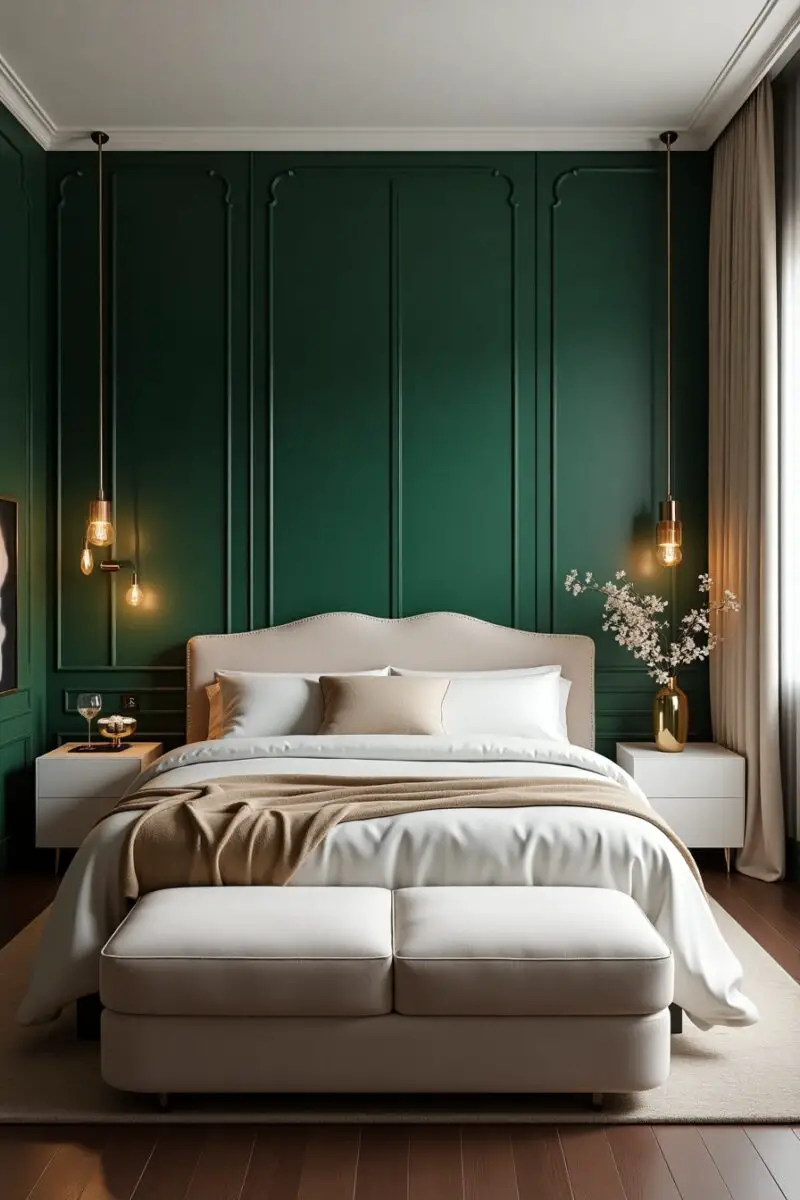
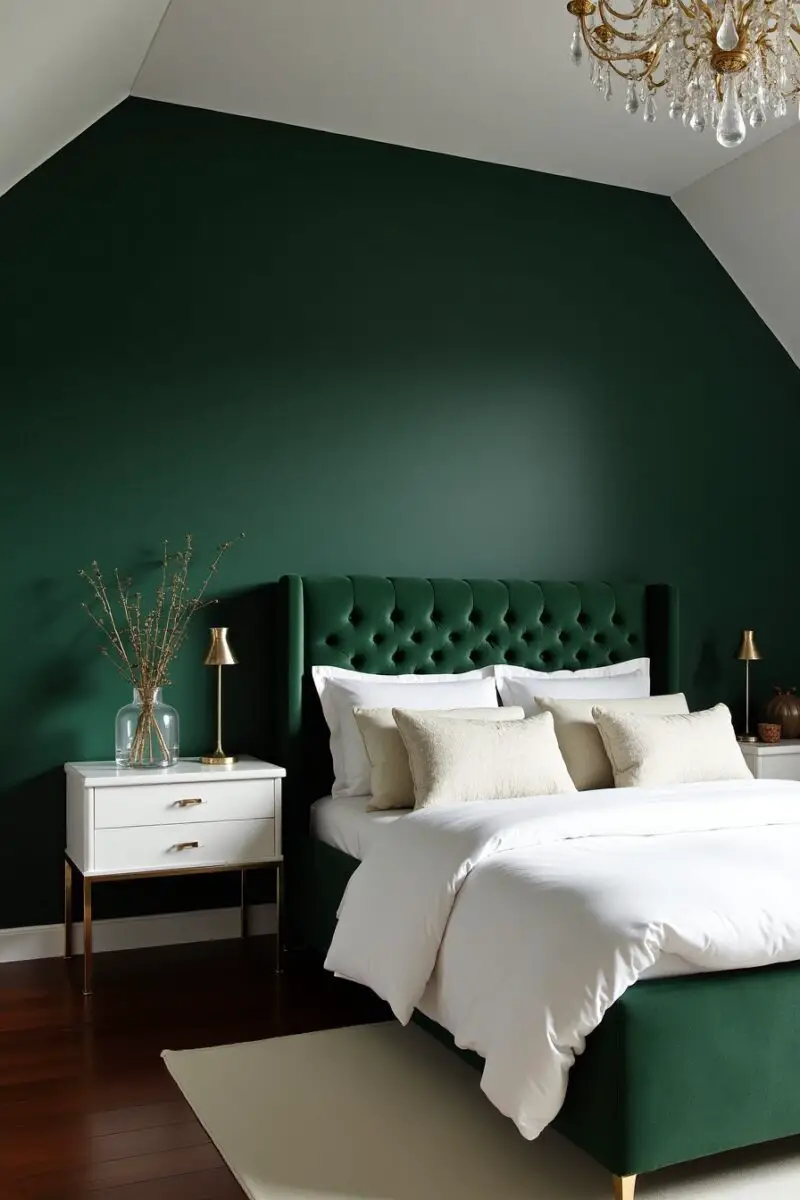

Emerald green delivers dramatic luxury that transforms a bedroom into a jewel box retreat when paired with crisp white accents.
This bold color combination creates a space that feels both opulent and fresh, perfect for someone who wants their bedroom to make a statement.
Start with rich emerald green on all walls – this jewel tone creates an instant sense of luxury and makes white elements pop dramatically.
Choose furniture in bright white for maximum contrast – a modern platform bed or a traditional upholstered frame both work beautifully against emerald walls.
For bedding, commit to hotel-worthy whites with subtle texture variations – think Egyptian cotton sheets, a quilted coverlet, and a fluffy duvet with minimal detailing.
Add a single accent pillow or throw in emerald that matches your walls exactly to create a seamless, thoughtful look.
Incorporate mirrors strategically – a large floor mirror and mirrored nightstands amplify light and create a sense of spaciousness within the rich color scheme.
For window treatments, choose simple white panels hung from ceiling to floor to emphasize height and maintain the clean contrast.
Lighting is crucial in this design – mix metals like brass or gold for a luxurious touch through statement pendant lights, sconces, or table lamps.
Area rugs work beautifully in either bright white for drama or a pattern incorporating emerald and white for a more nuanced look.
Artwork should be impactful but not competing – consider large-scale photography or abstract pieces in black and white with simple frames.
For accessories, be highly selective – a few white ceramic vessels, crystal objects, or a small collection of books with the dust jackets removed.
Consider a statement ceiling in high-gloss white paint or even wallpaper with a subtle pattern to draw the eye upward and create another dimension of interest.
Incorporate luxurious materials like velvet, silk, and lacquer to enhance the jewel-box feeling of the space.
A tufted bench or ottoman at the foot of the bed in either white or emerald adds functional seating and enhances the luxurious feel.
Keep technology discreet – this look is about timeless elegance rather than visible modern conveniences.
For nightstands, consider lacquered white pieces with brass hardware or glass-topped tables with gold bases for a touch of glamour.
Dresser styling should be minimal and intentional – perhaps a white tray for corralling perfume bottles, a small dish for jewelry, and a significant art object.
If you’re hesitant about all-emerald walls, consider using this rich tone on just the wall behind your bed, with the remaining walls in white.
The key to making this look successful is commitment – embrace the drama of the contrast rather than diluting it with too many additional colors.
Coastal Cool: Seafoam Green and White Retreat
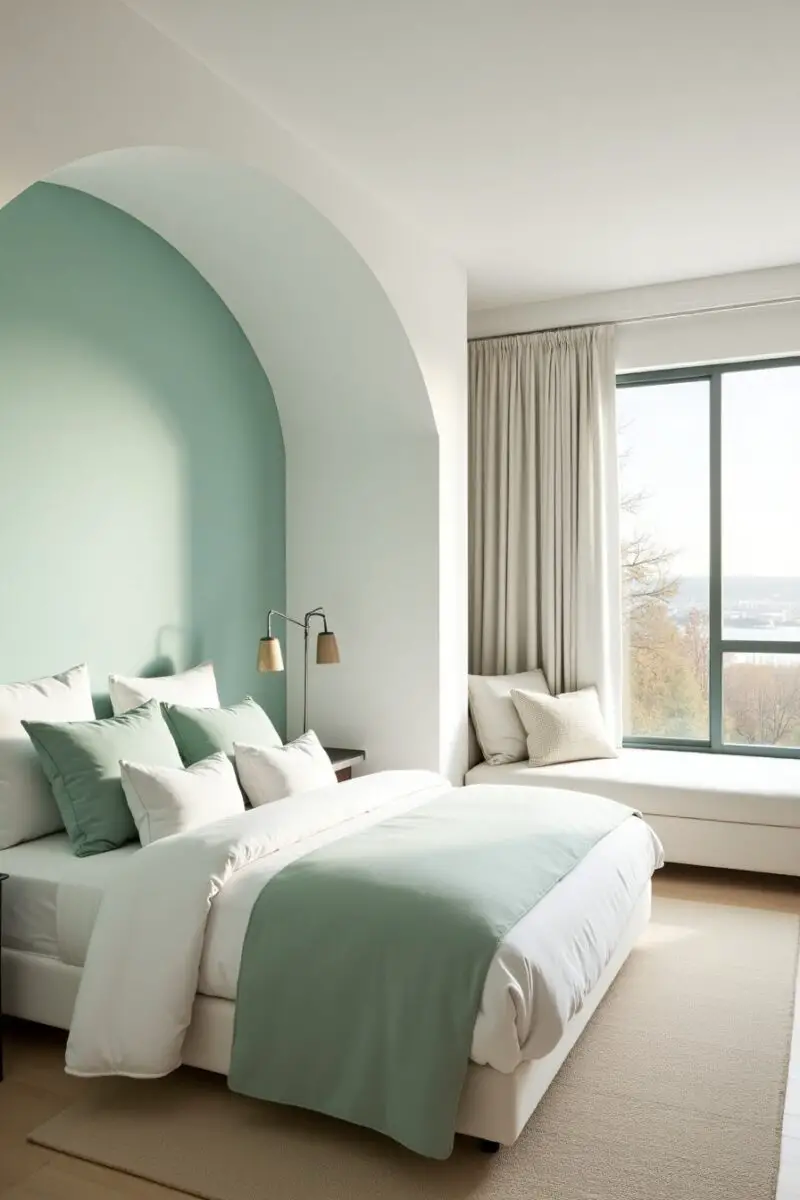
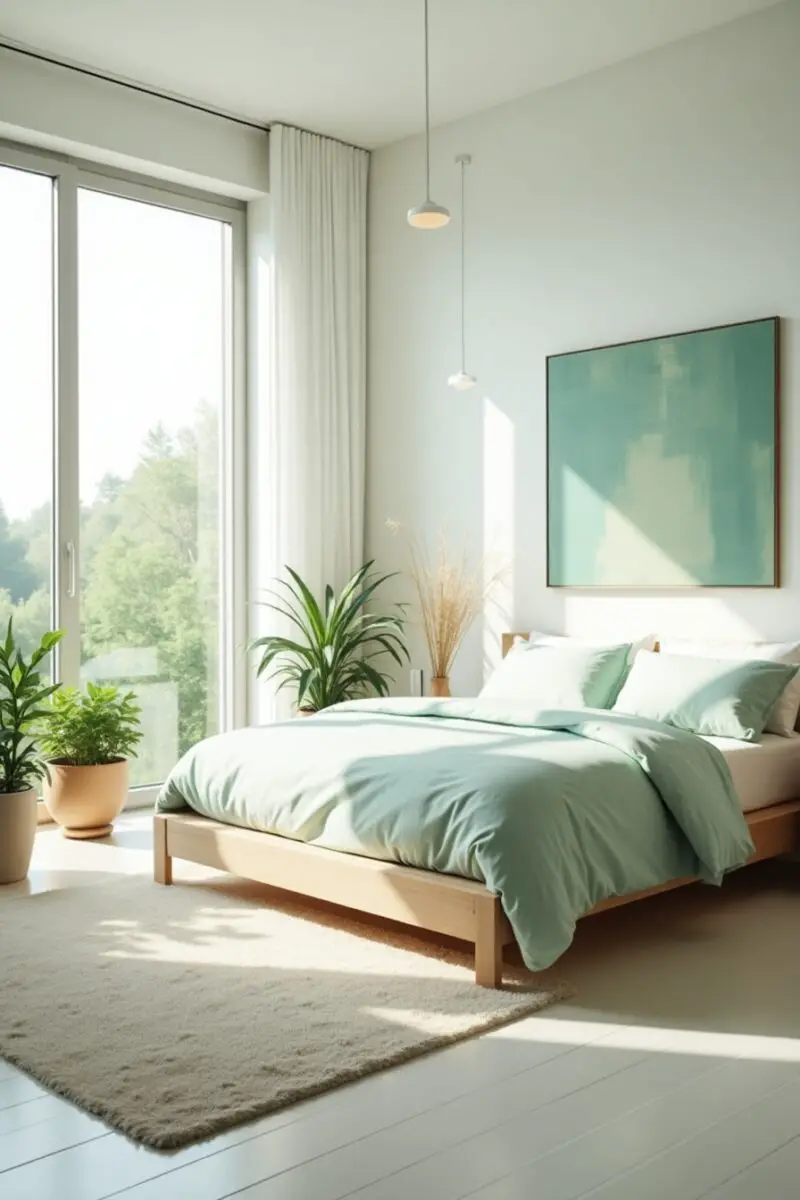
Seafoam green paired with bright white creates the ultimate beachy bedroom retreat that feels like a permanent vacation.
This color combination instantly evokes ocean breezes and seaside relaxation without resorting to obvious coastal clichés.
Start with walls in the palest seafoam green – almost white with just a hint of green – to create a soft, luminous backdrop that shifts with the changing daylight.
Choose furniture in either white or light natural woods like ash or bleached oak to enhance the airy, coastal feeling.
For your bed, consider an upholstered headboard in white linen or a wooden frame in a weathered whitewash finish – nothing too formal or structured.
Bedding should feel effortlessly casual in whites and pale seafoam – think stonewashed linen duvet covers, quilted cotton coverlets, and textural pillow shams.
Add one statement pattern through a throw pillow or lightweight blanket – perhaps a subtle watercolor print or abstract wave pattern in various shades of seafoam.
Window treatments should be minimal and breezy – consider simple white linen panels that can move with the breeze or woven wood blinds for texture.
Incorporate natural textures through rattan, jute, seagrass and rope elements – perhaps a pendant light, basket storage, or even a rope-wrapped mirror frame.
For flooring, light wood or whitewashed boards create the perfect foundation, topped with a natural fiber rug for barefoot comfort.
Lighting should evoke seaside elements – consider ceramic lamps in seafoam or white with natural linen shades, or pendants with glass elements that recall sea glass.
Artwork can reference the coast subtly – think abstract paintings in shades of seafoam, white and sand, black and white beach photography, or framed vintage sea charts.
Keep accessories minimal but meaningful – perhaps a collection of sea glass in a clear bowl, a few carefully selected shells, or a driftwood sculpture.
Add a comfortable reading chair in natural linen with a small side table for morning coffee with a view (even if that view is just your imagination).
For nightstands, consider weathered pieces with a story – vintage bedside tables painted white, small sailing trunks, or even stacked low bookshelves.
Incorporate reflective surfaces through mirrors and glass to amplify natural light and recall the shimmering quality of water.
A ceiling fan with white or pale wood blades provides both function and coastal style, creating a gentle breeze reminiscent of ocean air.
Storage should feel casual and accessible – perhaps open shelving for displaying favorite objects alongside practical items, or dressers with simple hardware.
For a contemporary coastal look, incorporate one or two black accents through picture frames or lamp bases to ground the airy palette.
The beauty of this design is its tranquility – it should feel like taking a deep breath of salt air every time you enter the room.
✨Click to Get My 101 FREE Designer Room Ideas
Vintage Charm: Mint Green and Antique White
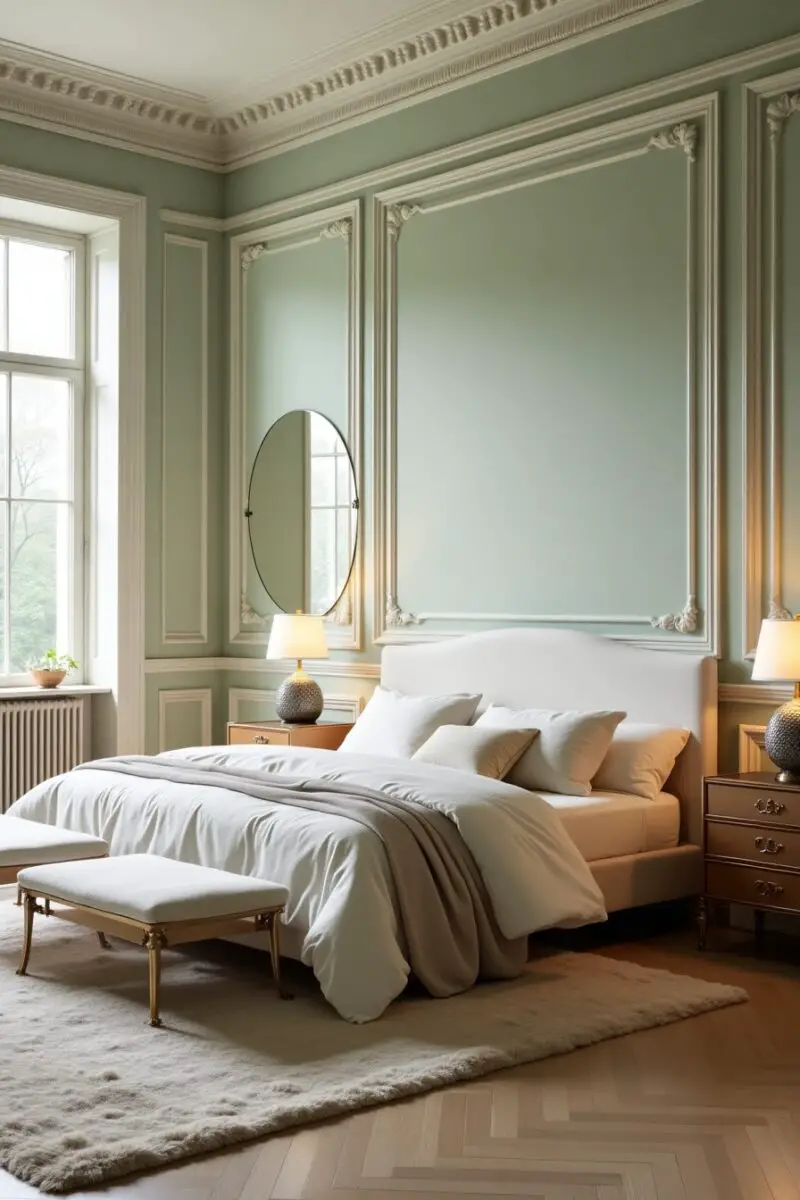
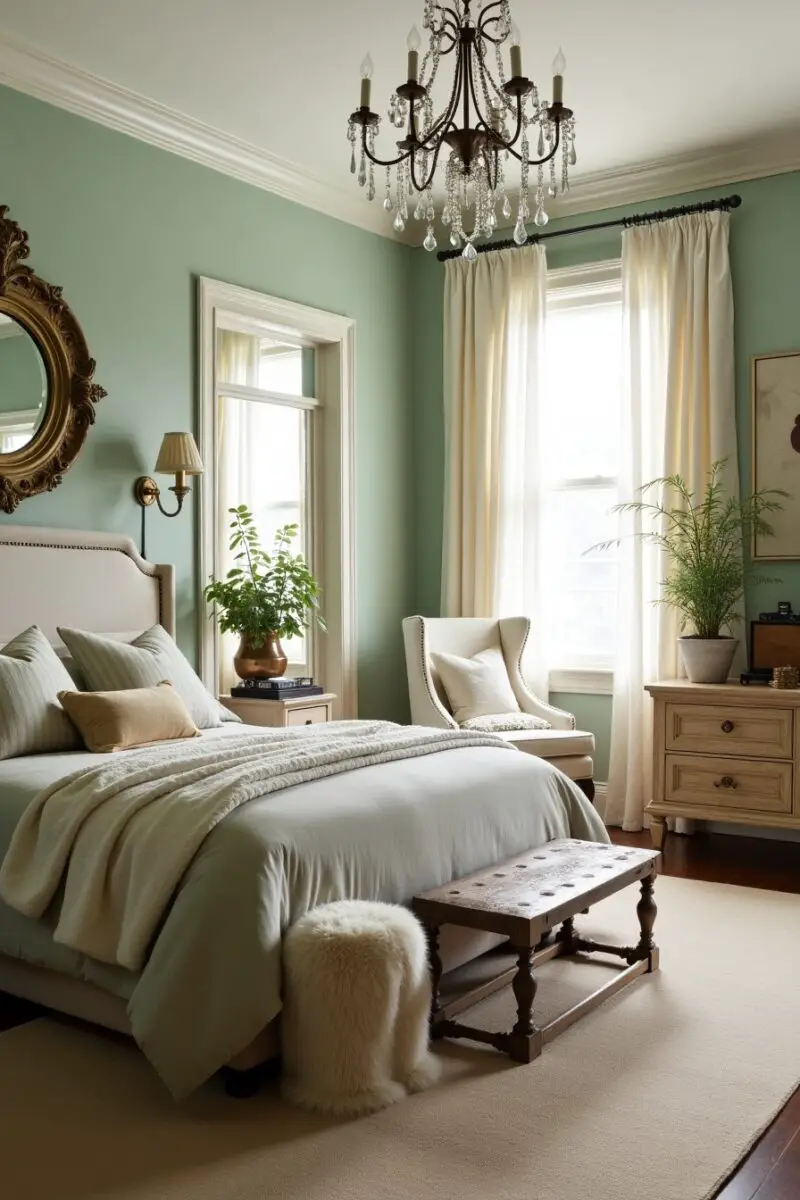
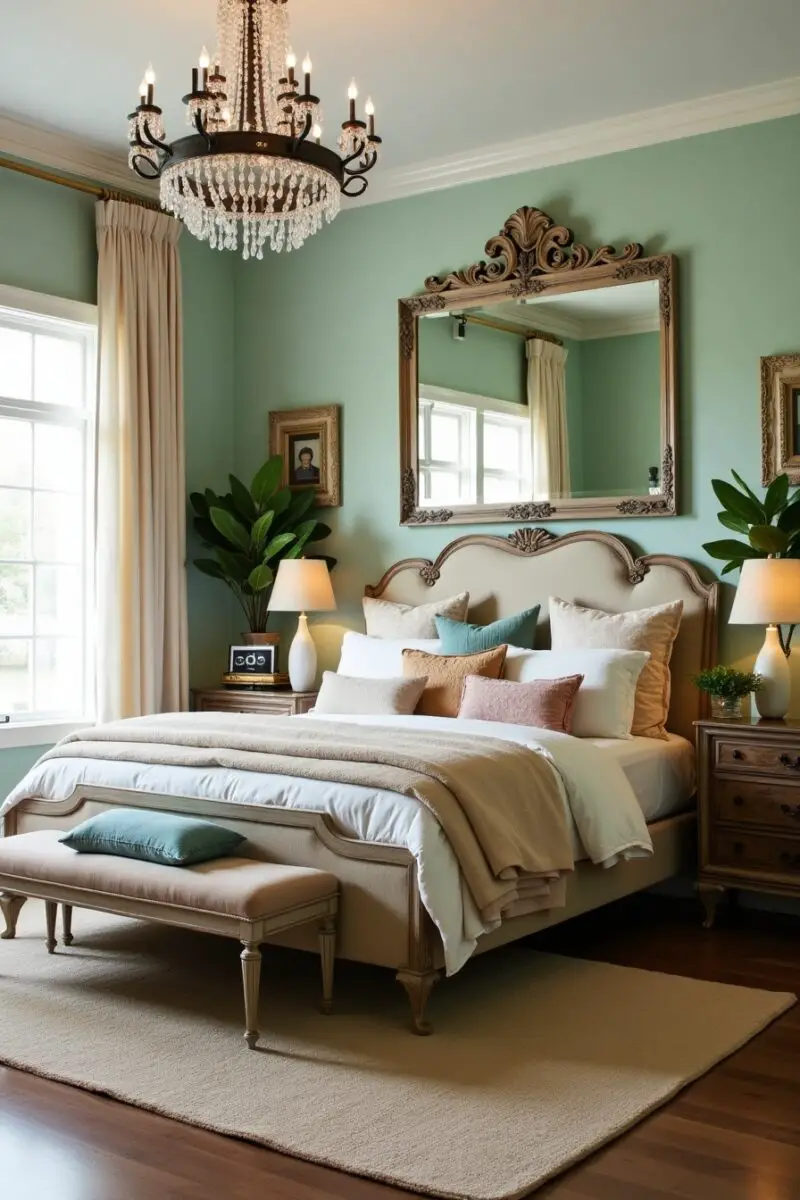
Mint green paired with antique white creates a bedroom with vintage charm that feels both nostalgic and fresh.
This color combination immediately evokes the gracious bedrooms of earlier eras while still feeling relevant and livable today.
Start with walls in a soft mint green with gray undertones for sophistication rather than sweetness – this creates a backdrop with vintage appeal that doesn’t feel childish.
Choose furniture with gentle curves and character – perhaps a painted wooden bed frame with simple detailing or an iron bed in antique white.
For larger pieces like dressers and armoires, look for vintage finds that can be painted in antique white or left in their original worn finish if it complements the palette.
Bedding should feel luxurious but not precious – layer antique white linens with subtle details like embroidery, light crochet trim, or delicate pintucking.
Add a vintage-inspired quilt or coverlet in a small-scale pattern that incorporates mint and white – think tiny florals, gentle stripes, or a subtle Swiss dot.
For window treatments, consider lace curtains in antique white or mint green roller blinds with scalloped edges for period-appropriate charm.
Incorporate antique mirrors with ornate frames painted in antique white to add reflection and a sense of history to the space.
Lighting should include elements like milk glass, ceramic bases in mint or white, and fabric shades with slight gathering or pleating for vintage flair.
For an authentic touch, seek out a small chandelier or pendant with crystal details that can be the crowning jewel of your vintage-inspired space.
Area rugs work beautifully in faded patterns that incorporate mint and antique white – look for washable options that recreate the look of worn antique rugs.
Artwork should enhance the vintage mood – consider framed botanical prints, watercolor landscapes, silhouettes, or black and white family photos in ornate frames.
Incorporate collections that tell a story – perhaps vintage hardcover books, milk glass vases, or antique perfume bottles arranged thoughtfully rather than cluttered.
Add one or two pieces of actual vintage furniture – a small writing desk, a vanity table, or a bedside chair – to ground the look in authenticity.
For nightstands, look beyond matching pairs – perhaps a small round table with a linen skirt on one side and a painted wooden nightstand on the other.
Storage can include visible elements like a vintage suitcase stack in the corner, an antique trunk at the foot of the bed, or a painted wooden blanket ladder.
Incorporate subtle patterns through wallpaper on one wall – perhaps a damask, small floral, or bird pattern in mint and white tones.
Hardware and fixtures should have aged character – consider glass knobs, brushed brass pulls, or ceramic handles with simple details.
The key to making this look successful is curation – each element should feel chosen for its beauty and meaning rather than as part of a matching set.
Scandinavian Simplicity: Olive and Creamy White
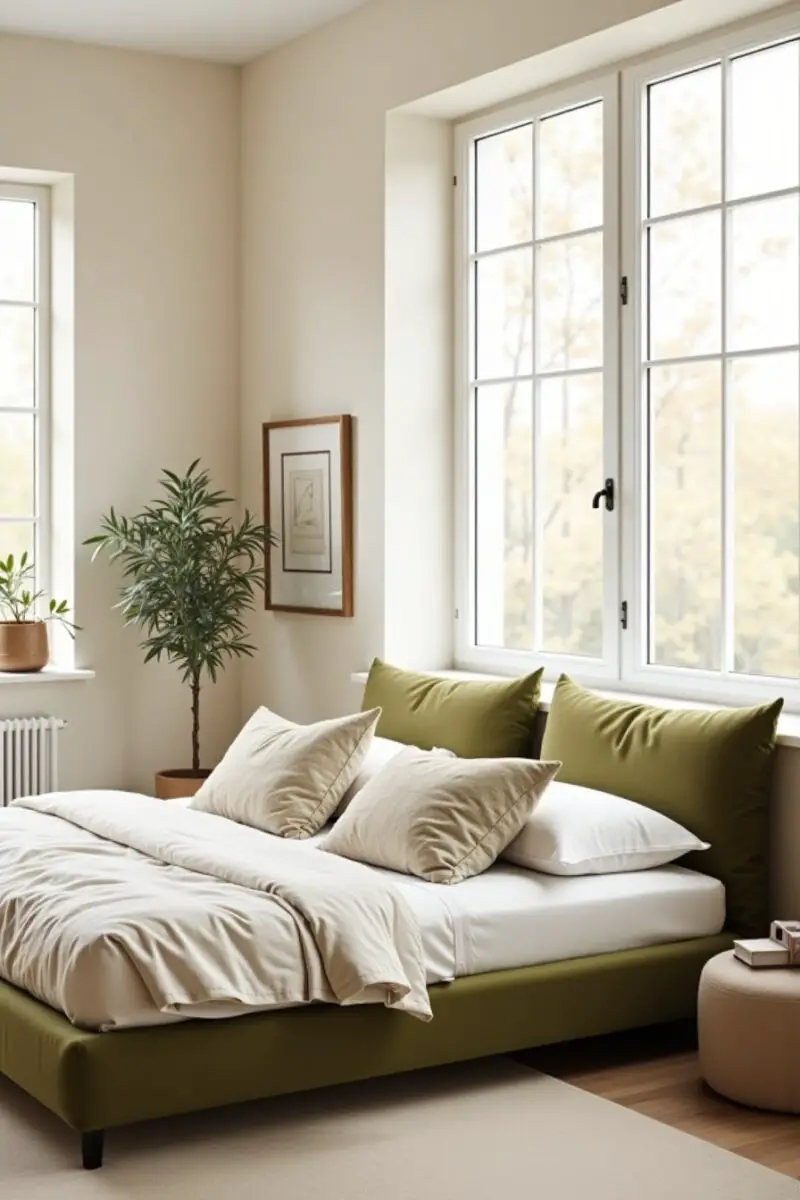
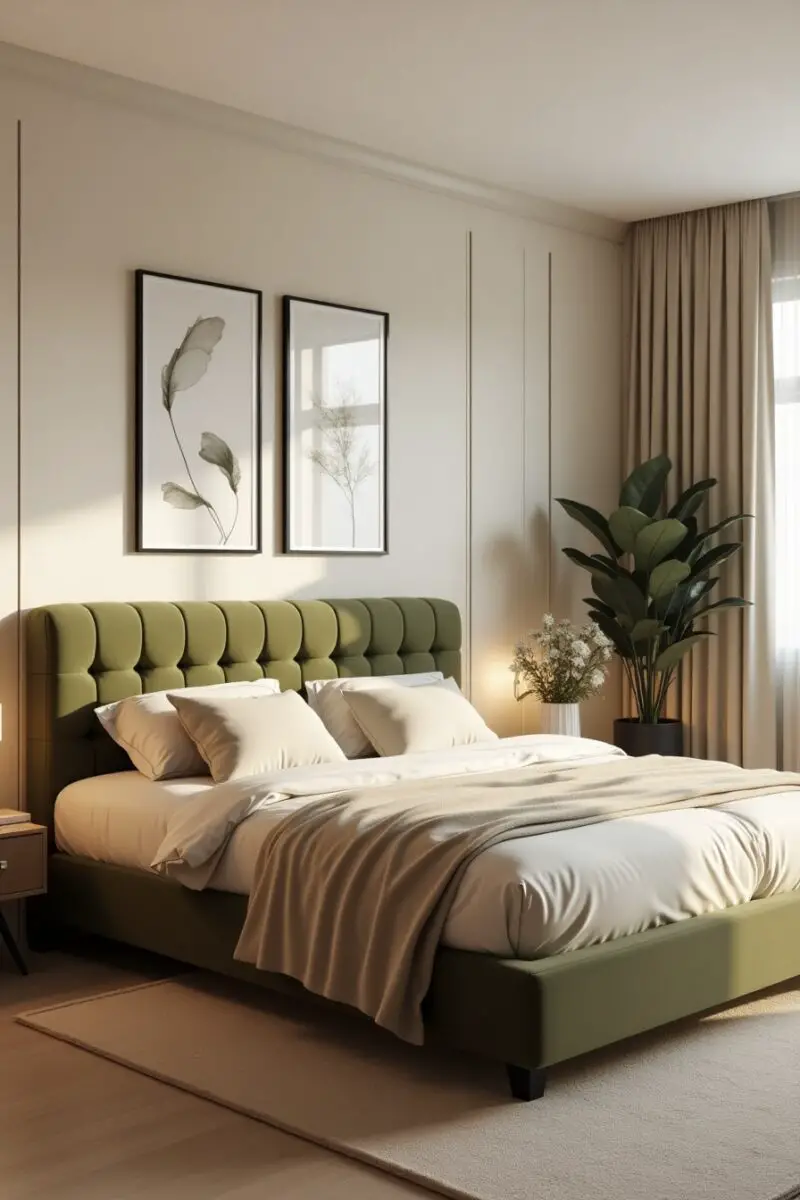
Olive green paired with creamy white creates a Scandinavian-inspired bedroom that feels both modern and deeply connected to nature.
This color combination offers a fresh take on Nordic design, introducing warmth through olive tones while maintaining the clean simplicity Scandinavian spaces are known for.
Start with walls in creamy white to create a warm, soft foundation that doesn’t feel stark or clinical like pure bright white might.
Choose furniture with clean lines and visible wood grain – look for pieces in light to medium oak that bring natural warmth to the space.
For your bed, consider a simple wooden frame with a minimal headboard or a platform style that sits low to the ground in typical Scandinavian fashion.
Introduce olive green through bedding – perhaps a duvet cover in a washed olive linen that brings organic color while maintaining the casual, lived-in Scandinavian aesthetic.
Layer with creamy white sheets and pillowcases in organic cotton, adding texture through a chunky knit throw in either olive or a natural undyed wool.
Window treatments should be minimal – consider simple roller blinds in olive green or wooden slatted blinds that can be fully opened during daylight hours.
For flooring, light wood is ideal, but if that’s not possible, incorporate a large area rug in a flat weave with subtle geometric patterns in olive and cream.
Lighting should combine form and function – pendant lights with simple paper or linen shades, adjustable reading lamps, and candles for hygge evening ambiance.
Incorporate natural materials wherever possible – wooden hooks instead of a traditional closet, a rattan bench, linen curtains, and wool textiles.
Artwork should be minimal but meaningful – perhaps one large landscape photograph, simple botanical illustrations, or abstract pieces in complementary earth tones.
Add plants that thrive in indirect light – fiddle leaf figs, olive trees, or trailing pothos in simple terracotta or white ceramic pots.
For nightstands, consider wall-mounted shelves instead of traditional tables to enhance the floating, airy feeling of Scandinavian design.
Storage should be intentional and, when possible, concealed – look for closed cabinets with simple fronts rather than open shelving that can collect clutter.
Incorporate subtle olive accents through ceramic vessels, a single upholstered chair, or even painted interior cabinet surfaces that reveal a surprise of color.
For a typical Scandinavian touch, add sheepskin throws over a bench or chair to create inviting texture and warmth.
Minimize decorative objects but choose ones with meaning – perhaps a hand-carved wooden bowl, a special book, or a single sculptural vase.
This style encourages “just enough” rather than excess – each item should earn its place through either beauty, function, or ideally both.
The olive and creamy white palette creates a bedroom that feels connected to the earth while maintaining the light, bright quality that makes Scandinavian spaces so appealing.
Tropical Glam: Palm Green and Pearl White
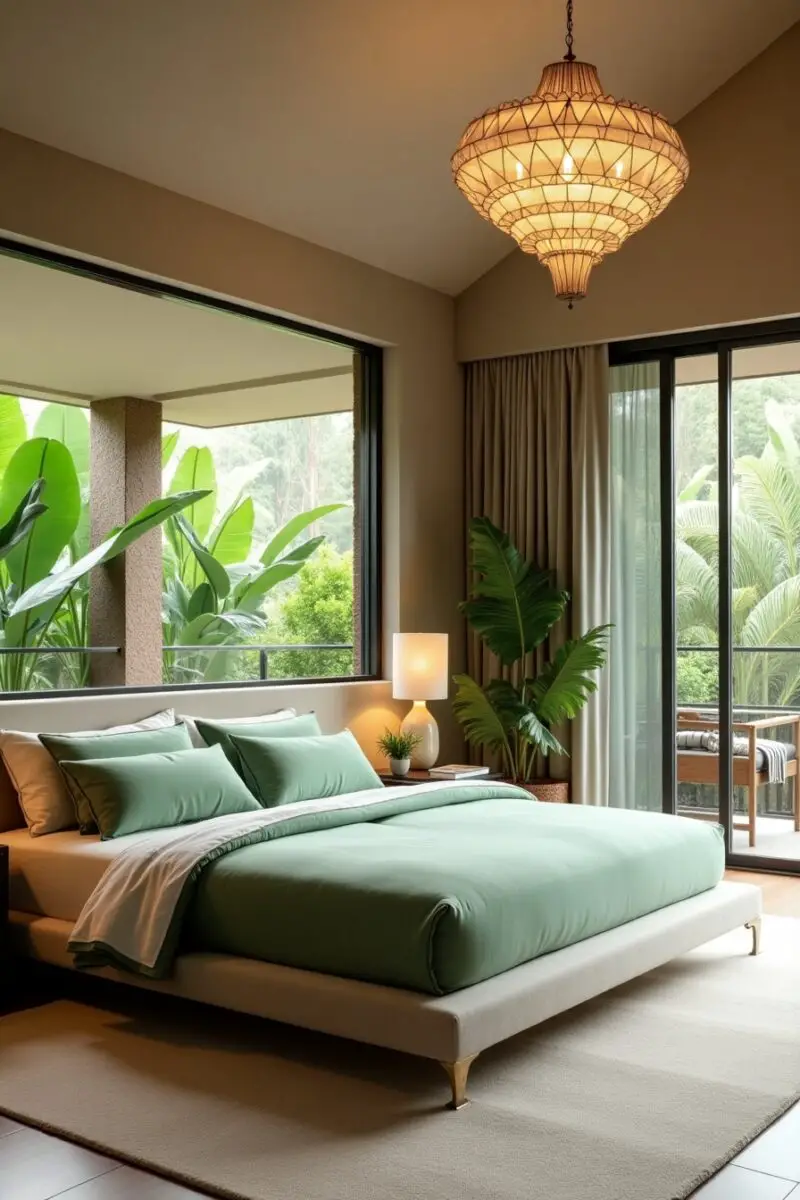
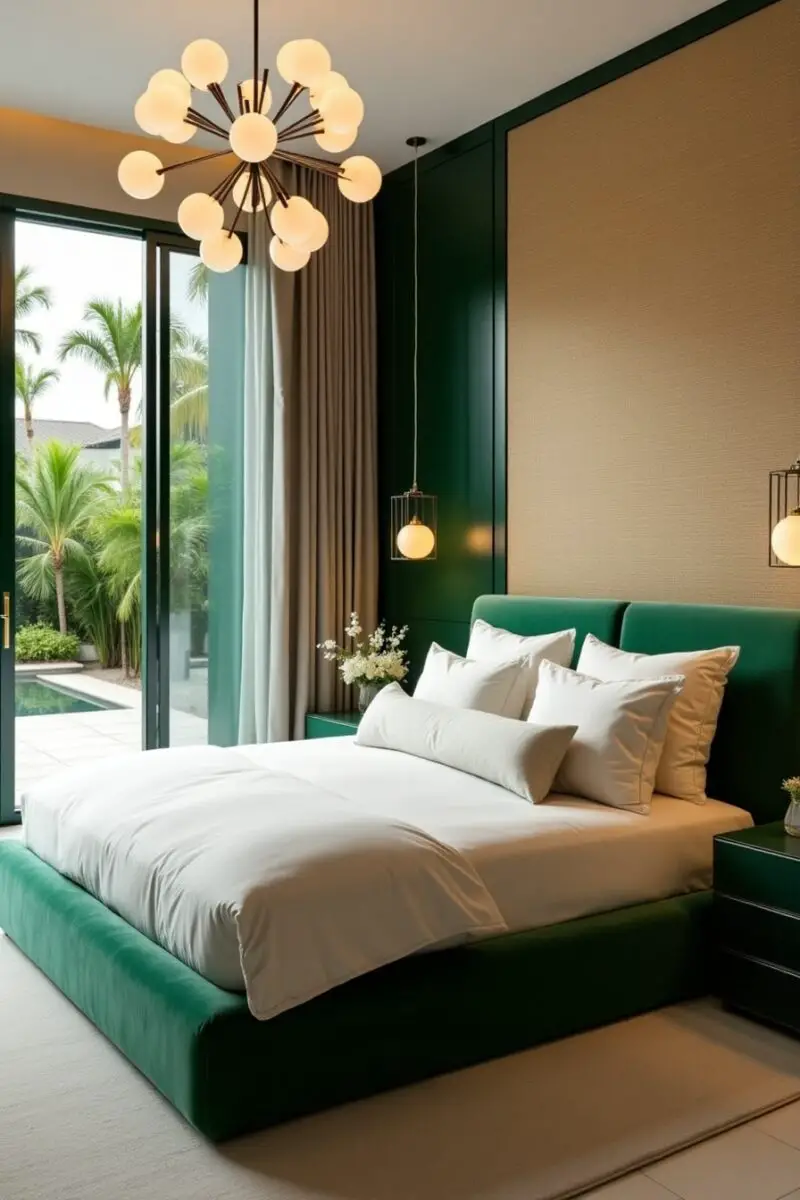
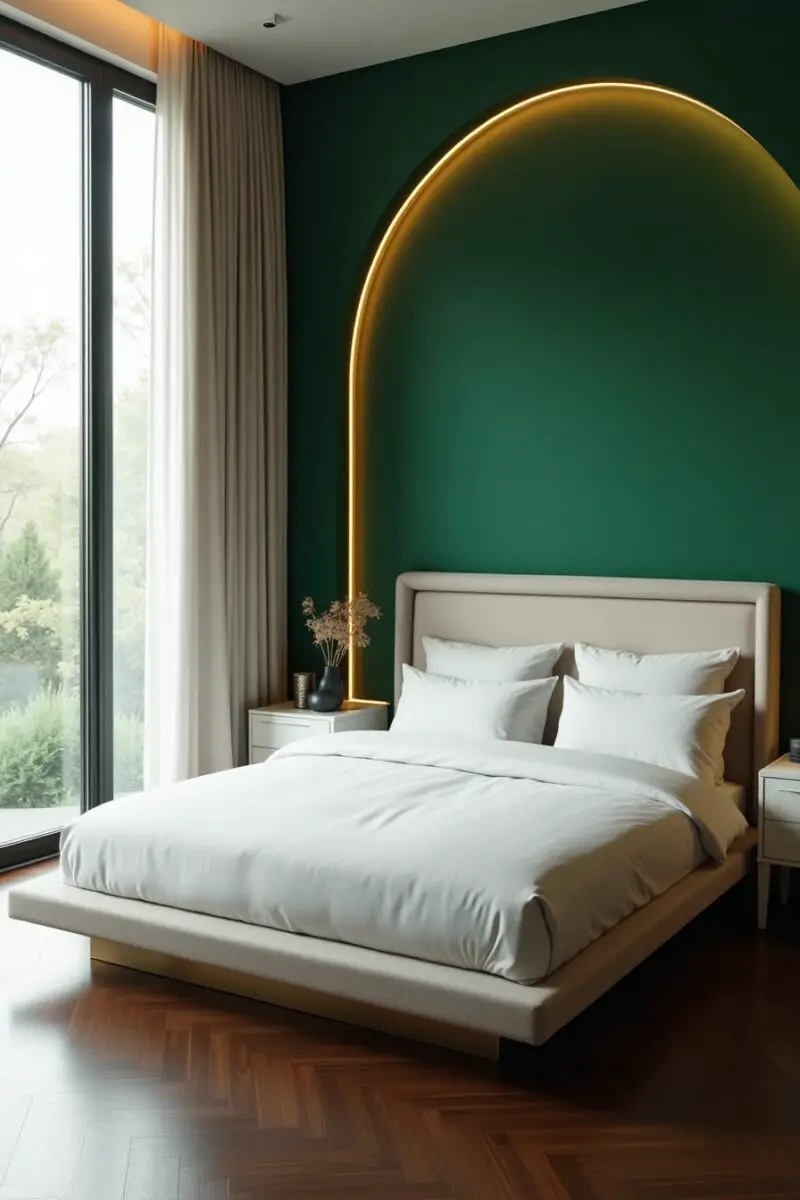
Palm green paired with pearl white creates a tropical glam bedroom that feels both exotic and sophisticated.
This color combination brings the lush vibrancy of tropical landscapes into your space while the pearl white adds refinement and prevents the look from becoming overwhelming.
Start with pearl white walls as your base – this soft, luminous white has subtle depth that plain white lacks, creating the perfect backdrop for rich palm green accents.
Choose a bed that makes a statement – perhaps an upholstered headboard in palm green velvet or a four-poster bed painted in glossy white.
For bedding, start with luxurious white sheets with a subtle sheen, then add a duvet or comforter in either solid palm green or a bold tropical print that combines the two colors.
Layer with accent pillows in varying shapes and sizes – some in solid palm green, others in white with green piping, and perhaps one feature pillow in a tropical print.
Window treatments should be dramatic – consider floor-to-ceiling panels in either white linen or a subtle palm print, hung from brass or gold rods for that touch of glam.
Incorporate tropical motifs through wallpaper on one feature wall – look for designs with palm fronds, monstera leaves, or banana leaves on a white background.
For larger furniture pieces like dressers and armoires, white lacquered pieces with gold or brass hardware create the perfect blend of tropical and glamorous.
Lighting should make a statement – consider pendant lights with natural materials like woven rattan combined with brass elements, or table lamps with ceramic bases in palm green.
Add a large mirror with a gold or white frame to amplify light and create a sense of expanded space typical of luxury tropical resorts.
Area rugs work beautifully in natural fibers like sisal or jute for tropical authenticity, or choose a white plush rug for more glamorous comfort underfoot.
Incorporate actual tropical plants if your light conditions allow – a large palm, bird of paradise, or monstera becomes living sculpture that enhances your color scheme.
For nightstands, look for pieces with interesting details – perhaps white tables with gold bamboo-inspired legs or green lacquered chests with brass handles.
Artwork should reinforce your theme without being cliché – consider black and white photography of tropical landscapes, abstract paintings in shades of green, or vintage botanical prints in gold frames.
Add one dramatic piece of furniture beyond your bed – perhaps a velvet bench in palm green at the foot of the bed or a white rattan peacock chair in the corner.
Incorporate touches of brass or gold throughout the space to enhance the glamorous feeling – picture frames, decorative objects, hardware, and light fixtures.
For accessories, be selective but impactful – a few white ceramic vessels, a lacquered box in palm green, and perhaps a vintage brass tray for corralling smaller items.
If your budget allows, consider a statement ceiling fan with palm-shaped blades or a design that references tropical vegetation for both function and style.
The key to making this look sophisticated rather than themed is balance – the palm green should be the star but not overwhelming, with pearl white and gold as supporting players.
Urban Jungle: Plant-Filled Green and White Haven
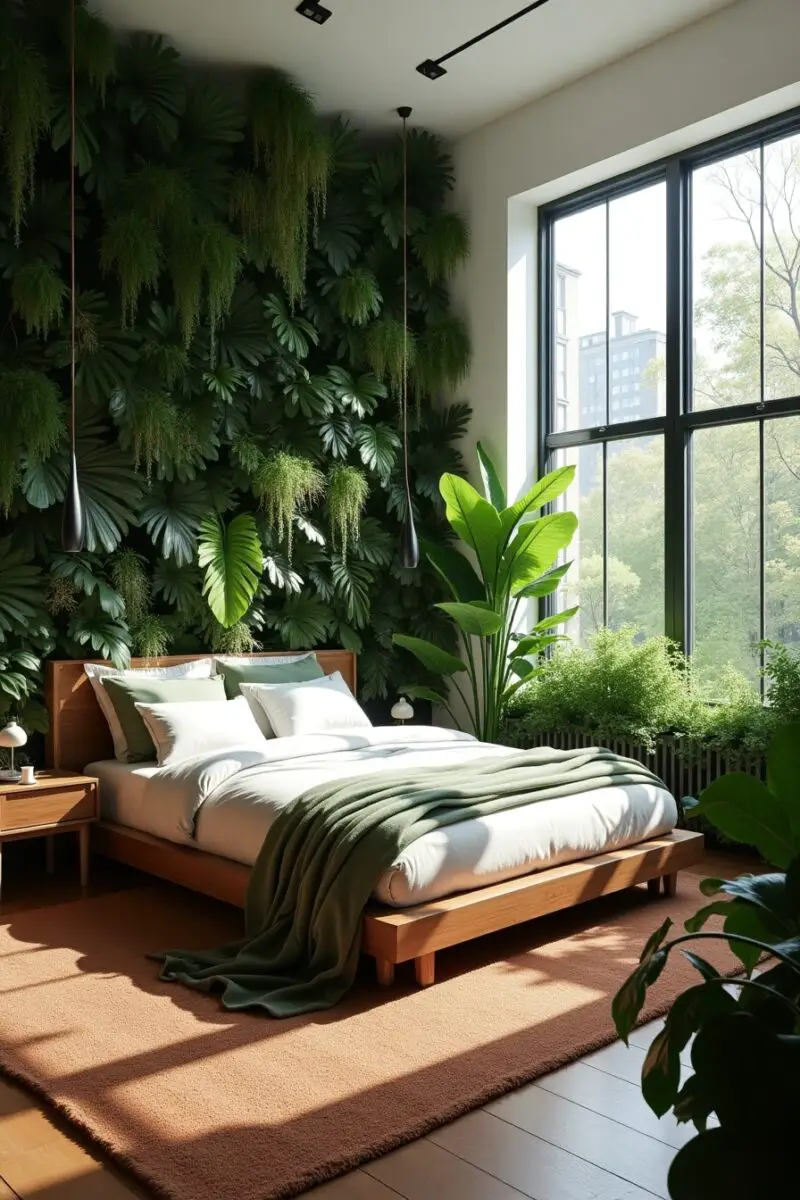

Creating an urban jungle bedroom means embracing a multitude of greens against a crisp white backdrop to form a plant-lover’s paradise in the heart of the city.
This design concept transforms your bedroom into a lush sanctuary where the boundaries between indoors and outdoors blur through strategic use of plants and natural elements.
Start with bright white walls, ceiling, and trim to create a clean gallery-like space where your plants and green accents can truly shine.
Choose furniture with simple lines in either white or natural wood tones that won’t compete with your botanical elements – the plants are the true stars of this show.
For your bed, consider a low platform style that creates a grounded feeling, dressed in crisp white linens with perhaps one or two accent pillows in various green tones.
The key feature of this design is plants – lots of them, in various sizes, shapes, and shades of green, creating a layered ecosystem effect throughout the space.
Incorporate plant stands, hanging planters, wall-mounted options, and shelving specifically designed to showcase your green collection at different heights.
Consider a canopy arrangement above the bed with trailing plants like pothos or string of pearls creating a living headboard effect that frames your sleeping space.
Window treatments should be minimal to allow maximum light for your plants – perhaps simple white roller blinds that can be fully retracted during the day.
For flooring, natural materials work beautifully – think light wood, bamboo, or cork – with perhaps a simple jute rug to add texture without competing with your greenery.
Lighting needs special consideration to support plant health – incorporate grow lights disguised as decorative fixtures for winter months or rooms with limited natural light.
Add a small water feature like a tabletop fountain to enhance the sensory experience with gentle sound and increased humidity that many plants will appreciate.
For artwork, consider botanical prints, macramé plant hangers that double as wall art, or even a vertical garden installation on one wall for living art.
Storage should include elements specifically designed for plant care – perhaps a stylish watering can, mister, and plant care tools displayed on a dedicated shelf.
Incorporate natural materials throughout – rattan, bamboo, cork, linen, and other plant-derived elements that enhance the connection to nature.
For nightstands, consider repurposing plant stands or small garden stools that reinforce the botanical theme while providing practical surface space.
Add mirrors strategically to reflect your plants and create the illusion of an even more expansive green space – a large mirror opposite your most dramatic plant arrangement doubles its visual impact.
Include a comfortable chair or floor cushions to create a meditation spot surrounded by greenery – the perfect place for morning coffee or evening unwinding.
Temperature and humidity considerations are important in this design – you might want to include a decorative humidifier that supports both your comfort and plant health.
The beauty of the urban jungle bedroom is that it’s constantly evolving as plants grow and change, creating a living space that feels dynamic rather than static.
✨Click to Get My 101 FREE Designer Room Ideas
Monochromatic Magic: Fifty Shades of Green and White
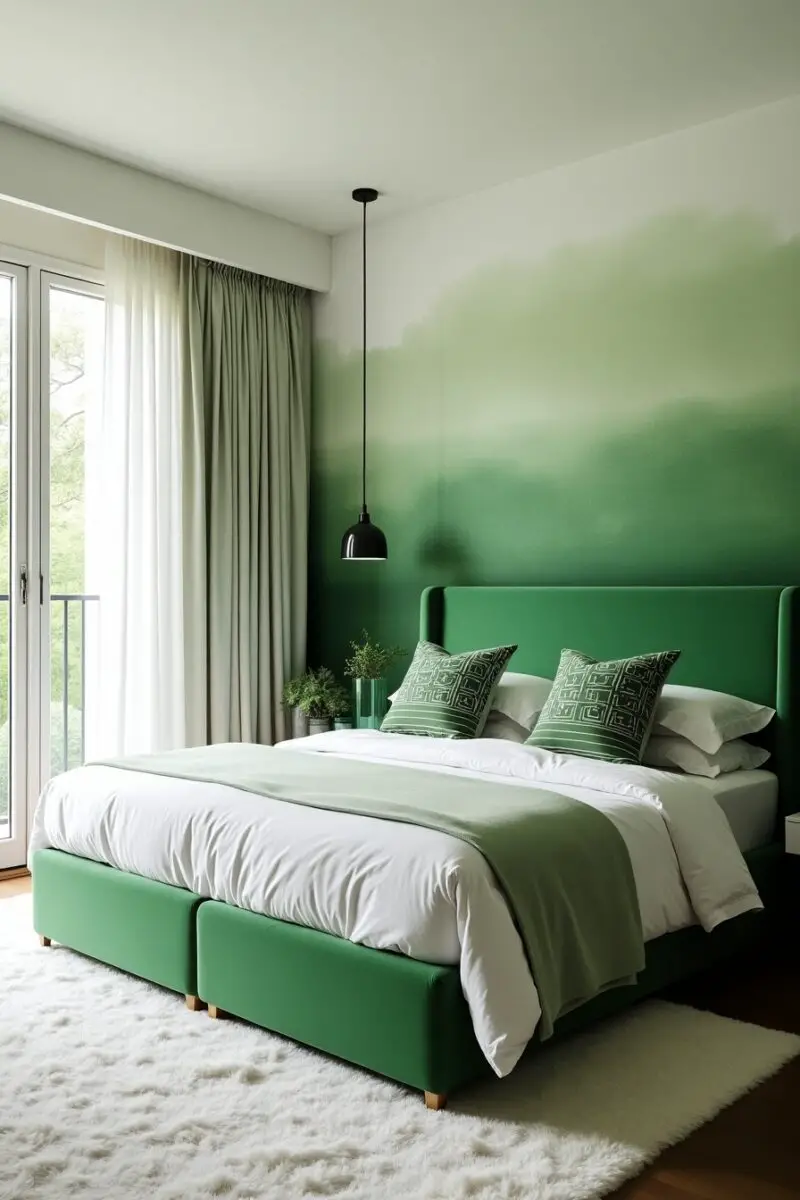
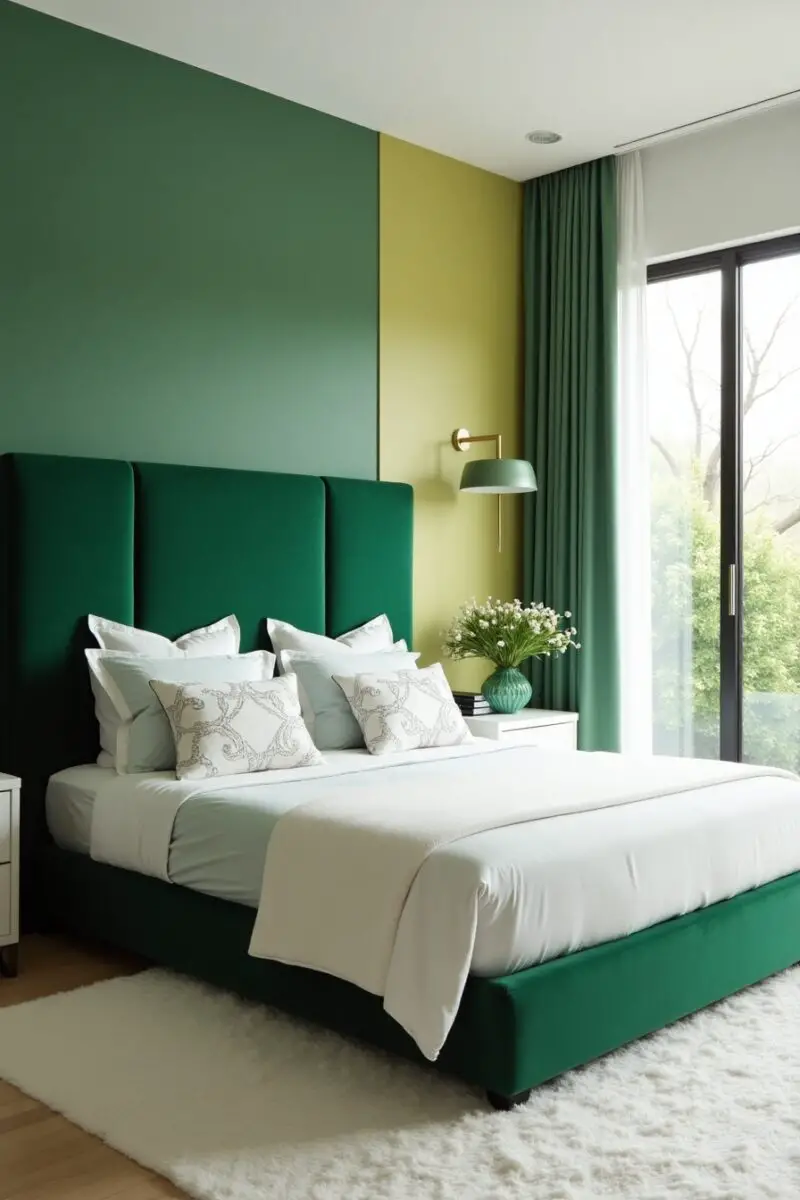
Creating a monochromatic bedroom with varying shades of green and white produces a sophisticated, layered space with visual depth despite the limited color palette.
This design approach focuses on texture, tone, and subtle variation to create interest without introducing additional colors.
Start with walls in a mid-tone green with gray undertones – this creates a sophisticated neutral backdrop that sets the stage for your monochromatic exploration.
Choose larger furniture pieces in either the lightest or darkest shades within your palette – perhaps a bed frame in bright white or a deep forest green velvet.
For bedding, layer multiple shades and textures – crisp white sheets, a sage green coverlet, and a duvet in a slightly deeper olive with white accents.
Add pillows in various shapes, sizes, and shades of green – from pale mint to deep emerald – with different textures like velvet, linen, and knits providing tactile variation.
Window treatments offer another opportunity for tonal play – consider white wooden blinds with drapery panels in a subtle green pattern or a textured sage green fabric.
For flooring, either light wood or white painted floors create the perfect foundation, topped with an area rug that incorporates several shades of green in a subtle pattern.
Lighting should include fixtures in white, clear glass, or metallic finishes that don’t introduce new colors but add shine and reflection.
Incorporate plants that offer different green tones – from blue-green succulents to yellow-green pothos to deep green ficus – creating a living color study.
Artwork should reinforce your palette – consider a gallery wall of frames in white and various green tones containing black and white photography or abstract pieces in complementary greens.
For accessories, focus on form and texture rather than new colors – white ceramic vessels, glass objects, and natural elements like driftwood or stones.
Incorporate mirrors to amplify light and reflect your carefully curated green and white elements throughout the space.
Consider using different finishes within your color scheme – matte, glossy, metallic, weathered – to create visual complexity without expanding the palette.
For nightstands, either match them or intentionally choose different pieces in complementary green tones – perhaps one in pale sage and one in deeper olive.
Storage pieces offer opportunities for color blocking – consider a dresser with the frame painted white and drawers in graduating shades of green from light to dark.
Add trim details in contrasting tones – perhaps white crown molding, green door frames, or a chair rail that divides the wall into two different shades of green.
For a subtle pattern, consider a tone-on-tone wallpaper on one wall – perhaps a damask or geometric in the same shade as your paint but with a slight sheen difference.
Incorporate natural elements that fall within your color scheme – green-tinted glass, white stones, or dried botanical elements in pale green.
The key to successful monochromatic design is intentional variation – too similar and the room feels flat, too contrasting and you lose the soothing effect of the limited palette.
Art Deco Reimagined: Jade Green and Brilliant White
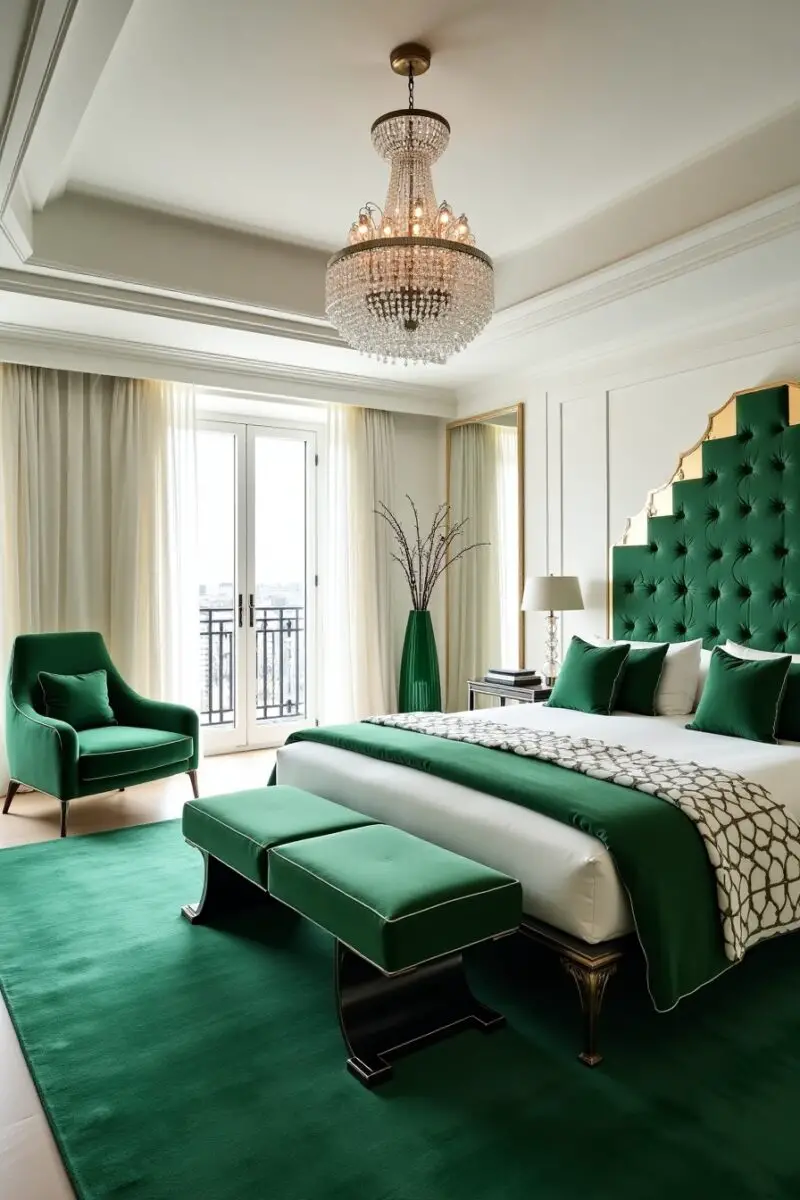
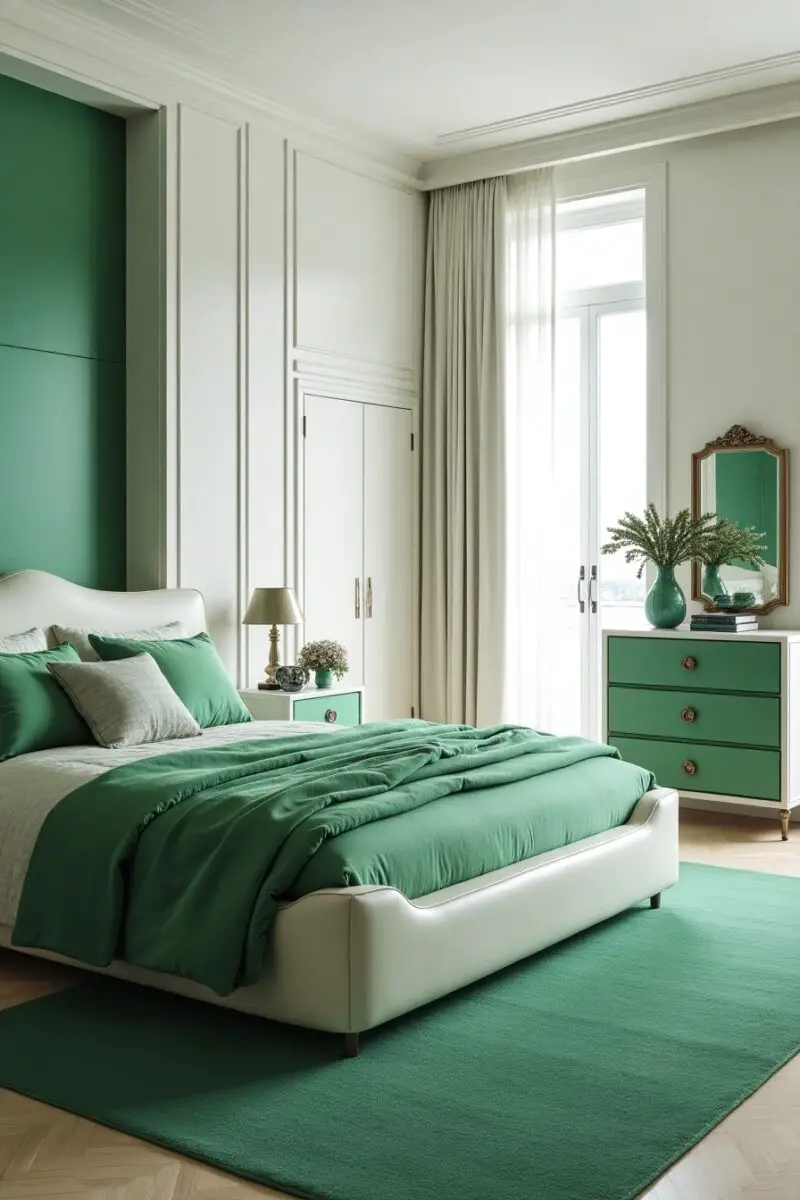
Art Deco design gets a modern update through the striking combination of jade green and brilliant white, creating a bedroom that’s both vintage-inspired and thoroughly contemporary.
This bold pairing captures the glamour of the 1920s and 30s while feeling fresh and relevant for today’s design-savvy homeowner.
Start with brilliant white walls as your canvas, but add architectural interest through applied geometric moldings painted in the same white for subtle texture and dimension.
Choose a statement bed with Art Deco lines – perhaps a channel-tufted headboard in rich jade green velvet with characteristic curved corners and vertical fluting.
For larger furniture, look for pieces with the hallmark symmetry and bold shapes of Art Deco – lacquered white dressers with jade green inlay or distinctive hardware in polished brass.
Incorporate mirrored surfaces strategically – perhaps nightstands with mirrored drawers or a full-length mirror with a white frame featuring geometric jade green accents.
Lighting is crucial in this design – choose fixtures with white glass globes, brass details, and geometric patterns that cast interesting shadows on your walls.
Add a sunburst mirror above the bed or dresser as a quintessential Art Deco touch that draws the eye and adds a focal point to the room.
For window treatments, consider white panels with a bold jade green border or geometric pattern at the bottom, hung from brass rods with finials featuring simple spheres or fans.
Layer your bed with brilliant white linens but add jade green accents through a throw or decorative pillows featuring geometric patterns like chevrons, fans, or stepped designs.
Area rugs should make a statement – look for designs with bold geometric patterns in jade green and white, perhaps with small accents of black or brass for authenticity.
Incorporate unexpected curves through a jade green chaise lounge or rounded ottoman that contrasts with the more angular elements in the room.
For artwork, consider vintage travel posters, abstract geometric prints, or black and white photography in white frames with jade green mats.
The beauty of green and white bedroom designs lies in their incredible versatility and timeless appeal.
If you’re drawn to the minimalist sanctuary of forest green, the lush botanical paradise, or the glamorous jade of Art Deco, there’s a green and white palette that perfectly expresses your personal style.
I’ve watched countless friends transform their sleeping spaces with these color combinations, and the results are always breathtaking.
The most successful green and white bedrooms aren’t just beautiful—they create a tangible sense of tranquility that you can feel the moment you walk through the door.
Remember that your bedroom should be your sanctuary, a place that both energizes you in the morning and soothes you at night.

